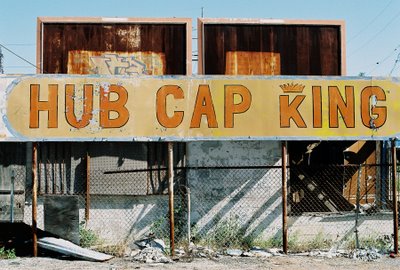Life in New Orleans
 Repaired Truck Body, Baton Rouge LA 11/2006
Repaired Truck Body, Baton Rouge LA 11/2006from the series Baton Rouge Blues
all reproduction rights reserved William Greiner
Survey looks at life in N.O.
One-third queried consider leaving
By JOE GYAN JR.
Advocate New Orleans bureau
Published: Nov 29, 2006
NEW ORLEANS — Against the backdrop of “For Sale’’ signs dotting yards across Orleans and Jefferson parishes, a new survey of 400 residents living in those parishes revealed Tuesday that a third of them may be leaving the area within the next two years.
The results of the “Keeping People’’ quality-of-life poll conducted last month by University of New Orleans political scientist and UNO Survey Research Center director Susan Howell indicate that a third of the surveyed residents in both parishes are either “very likely’’ or “somewhat likely’’ to leave in that period.
Seventeen percent of the residents in both parishes said they are “very likely’’ to leave while 15 percent in both parishes said they are “somewhat likely’’ to leave.
Sixty-seven percent of the Orleans residents and 65 percent of the Jeffersonians said they were “not very likely’’ to leave. The remainder said they did not know.
“If we consider only those who say ‘very likely’, it represents the potential for a large out-migration in the near future,’’ Howell said during a news conference at UNO.
Orleans residents cited crime, government inaction, lack of available housing and broken infrastructure as the biggest problems facing the parish and their main reasons for wanting to leave, while Jefferson residents listed crime, government inaction, levees/flood control and lack of available housing as the chief problems facing their parish and their reasons for leaving.
“After seeing the devastation in Orleans, Jefferson residents are aware that they are at risk from flooding in a future hurricane,’’ Howell said. “Completion of flood prevention projects, raising levees, and public information about these projects will give residents confidence to stay.’’
Howell’s team interviewed the Orleans and Jefferson residents from Oct. 19-24 using a random digit-dialing procedure that does not capture cellular telephones. Forty-five percent of the Orleans residents surveyed were black; 24 percent of the Jeffersonians polled were black. The survey had a sampling error of 7 percent in both parishes.
Howell cautioned that the respondents were not evacuees. Rather, they are the people in the “best’’ living conditions because they are in a house or apartment that is renovated enough to have a land-based phone, she said. They are presumably not in trailers.
Asked if her team could have gone door-to-door to interview trailer occupants, Howell smiled and said, “With a lot of money, sure.’’
Howell conducted a similar survey of 204 Orleans residents and 266 Jefferson residents in the spring. Those residents were not asked if they were considering leaving the area.
But they were asked in both surveys about their overall satisfaction with life in their respective parish.
The satisfaction level in Jefferson was 89 percent in April and 87 percent last month, while the level in Orleans was 48 percent in April and 53 percent last month.
“Satisfaction with life in Orleans is lower than in Jefferson, which is predictable given the flooding in Orleans. What is troubling is that there has been no improvement in satisfaction over the past seven months,’’ she said.
Howell also said there was no improvement from the spring survey to the fall survey in the indicators of mood and depression among Orleans and Jefferson residents.
“One-fifth or more of the residents of both parishes are irritable, sad, tired, feel everything is an effort, have trouble falling asleep, or cannot keep their mind on track nearly every day,’’ she said. “These indicators are important to track in the future because they are related to the likelihood of moving out of the area.’’
More than 20 percent of the recently surveyed residents also reported that their family income is still lower than it was pre-Katrina.
“These residents are, predictably, more likely to leave than those whose income is stable or has increased,’’ Howell said.
Howell’s team did find several bright spots in the survey:
Seven months ago, two-thirds of the respondents said they were worried about what would happen to them in the future.
Today, about half of the Orleans and Jefferson residents express that level of worry about their future.
She said that could be attributable to the fact that the latest survey was conducted at the end of the active part of the hurricane season.
Life has become less difficult than it was seven months ago. People are reporting greater ease in shopping for groceries, other shopping, sending and receiving mail, and getting around town.
In Orleans Parish, the number of residents saying their family income has decreased since Katrina is less than it was in April.New Orleans Mayor Ray Nagin’s approval rating is 40 percent — 61 percent among black residents and 23 percent among white residents. Jefferson Parish President Aaron Broussard, in spite of his controversial decision to send the parish’s pump station operators out of town during Katrina, is enjoying an approval rating of 53 percent.
By identifying the key problems that residents are facing and their evaluations of current government services and conditions, Howell said she hopes her survey will provide guidelines for public policy.
“What will happen to this report is up to the policymakers,’’ she said.



















